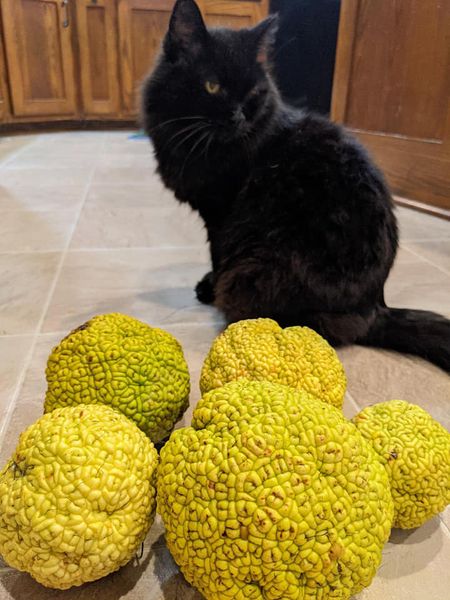I was comparing pictures from my old camera, new camera, and phone, and I came upon some Osage oranges, or what my grandpa calls "hedge apples" - the green things that look like bumpy grapefruits with black hairs. It might look strange, but this is a fascinating plant with a cool history.
Maclura pomifera is an evolutionary anachronism; whatever evolved to eat the fruit and spread its seeds is now extinct. Scientists believe the giant sloth or mastodon might have dined on these tough fruits and spread the fruit through droppings. Some of today's animals have occasionally been seen eating the fruit, but it is not their preferred food.
While this small tree might not have a place in the current food web, humans have found the wood to be every useful and have expanded the tree's range. The Osage tribe discovered that the orange-tinted wood is ideal for bows (thus the name "Osage orange"). Settlers planted the trees in rows to create impenetrable, thorny hedges to protect their gardens (thus the name "hedge apple"). After barbed wire was invented, the hedge apple fences went out of vogue. The wood is still valued for its use in fence posts due to its strength and rot resistance, and as firewood since it burns long and hot. There is also anecdotal evidence that the fruits serve as an insect deterrent when placed around the foundation of a house or in the basement, but that has not yet been proven in scientific studies.
Maclura pomifera is an evolutionary anachronism; whatever evolved to eat the fruit and spread its seeds is now extinct. Scientists believe the giant sloth or mastodon might have dined on these tough fruits and spread the fruit through droppings. Some of today's animals have occasionally been seen eating the fruit, but it is not their preferred food.
While this small tree might not have a place in the current food web, humans have found the wood to be every useful and have expanded the tree's range. The Osage tribe discovered that the orange-tinted wood is ideal for bows (thus the name "Osage orange"). Settlers planted the trees in rows to create impenetrable, thorny hedges to protect their gardens (thus the name "hedge apple"). After barbed wire was invented, the hedge apple fences went out of vogue. The wood is still valued for its use in fence posts due to its strength and rot resistance, and as firewood since it burns long and hot. There is also anecdotal evidence that the fruits serve as an insect deterrent when placed around the foundation of a house or in the basement, but that has not yet been proven in scientific studies.

